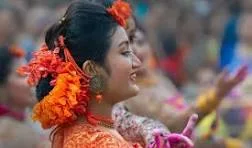The Rich Cultural Tapestry of Nepal
Nestled in the lap of the Himalayas, Nepal is a land of vibrant cultures, diverse ethnicities, and age-old traditions. Its cultural heritage is a blend of Hindu and Buddhist influences, with an array of unique customs, festivals, art forms, and social practices that reflect its multifaceted identity. This article explores the various dimensions of Nepal's rich cultural tapestry.
Ethnic and Linguistic Diversity
Nepal is home to over 120 ethnic groups, each with its own distinct language, customs, and traditions. The major ethnic groups include the Newars, Tharus, Tamangs, Gurungs, Magars, and Sherpas, among others. Nepali, the official language, is widely spoken, but the country also boasts over 100 local languages and dialects, reflecting its linguistic diversity.
Religion and Spirituality
Hinduism and Buddhism are the predominant religions in Nepal, deeply influencing its cultural practices. The two religions coexist harmoniously, often blending in festivals and rituals. Temples, stupas, and monasteries dot the landscape, serving as centers of spiritual activity.
Hinduism: The majority of Nepalis are Hindus. The Pashupatinath Temple in Kathmandu is one of the most significant Hindu temples, attracting pilgrims from all over the world. Hindu festivals like Dashain and Tihar are celebrated with great fervor, involving elaborate rituals, feasts, and family gatherings.
Buddhism: Buddhism also has a profound presence, especially in the Kathmandu Valley, which is home to the Swayambhunath (Monkey Temple) and Boudhanath stupas, important pilgrimage sites for Buddhists. The birth of Siddhartha Gautama, the Buddha, in Lumbini, further cements Nepal's status as a crucial site in Buddhist heritage.
Festivals and Celebrations
Nepali festivals are colorful and vibrant, characterized by music, dance, and communal participation. Some of the major festivals include:
- Dashain: The longest and most significant festival in Nepal, symbolizing the victory of good over evil. Families come together to receive blessings, exchange gifts, and partake in feasts.
- Tihar: Known as the festival of lights, Tihar is celebrated by decorating homes with oil lamps and colorful designs (rangoli). It honors different animals on different days, culminating in Bhai Tika, where sisters pray for their brothers' long life and prosperity.
- Holi: The festival of colors, where people smear each other with colored powders and water, celebrating the arrival of spring.
- Teej: A festival dedicated to women, where they fast and pray for marital bliss and the well-being of their husbands.
Art and Architecture
Kathmandu Valley: The valley is a UNESCO World Heritage site, encompassing seven groups of monuments and buildings. The Durbar Squares of Kathmandu, Bhaktapur, and Patan showcase the exquisite artistry and architectural prowess of the Malla period.
Thangka Paintings: These are traditional Tibetan Buddhist paintings on cotton or silk, depicting Buddhist deities, scenes, or mandalas. Thangkas are used for meditation and teaching purposes.
Music and Dance
Music and dance are integral parts of Nepali culture. Traditional instruments like the sarangi (a string instrument), madal (a type of drum), and bansuri (bamboo flute) are commonly used. Folk songs and dances vary among ethnic groups, each narrating tales of love, valor, and daily life.
Gai Jatra: A festival where families who have lost a member in the past year parade a decorated cow through the streets, accompanied by traditional music and dance.
Tamang Selo: A popular form of folk music and dance among the Tamang community, characterized by lively rhythms and vibrant movements.
Nepal's culture is a living, evolving mosaic of traditions and practices passed down through generations. Its festivals, art, music, and daily customs reflect the resilience and unity of its people amidst diversity. As Nepal continues to modernize, it remains rooted in its rich cultural heritage, offering a unique glimpse into the heart of the Himalayas.








